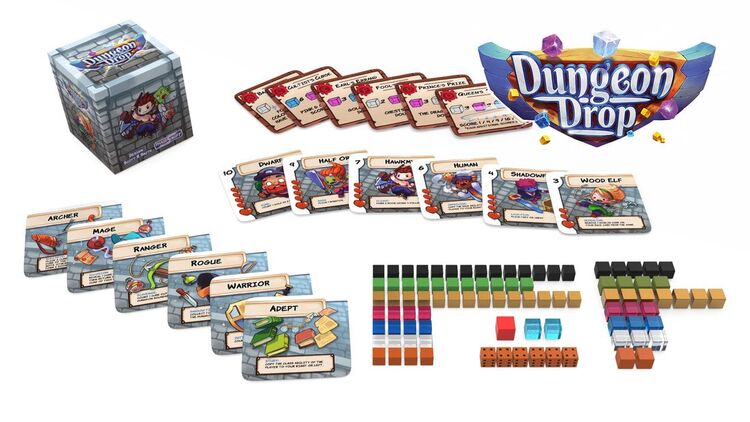I’m known as one of the family gaming guys. So, naturally, I’m sent and shown a lot of games that purport to be family friendly and accessible to younger gamers.
A lot of the games we see attempt to take complex game types like dungeon crawlers, RPGs, dexterity games, etc and eschew some of the mechanics or components to simplify the experience. This approach works wonders because most kids love to play games and just need a few obstacles cleared out of their way in order to really enjoy themselves.
The Game!
Dungeon Drop achieves this simplicity in an elegant and clever way: it skips the entire concept of a game board.Look. I know what you’re saying. How, exactly, do they do that?
Honestly, the answer is so simple you are going to be embarrassed that you didn’t think of it on your own. (I know I am!) – They skip the board part entirely.

The titular “Dungeon” in Dungeon Drop is created by dropping an assortment of colored cubes onto the play surface. Each colored cube represents a different object ranging from grey pillars (which help form the rooms) to orange keys, and green Boblins. (No. I didn’t spell that wrong.)
On their turn, each player sprinkles a few more cubes into the playing field to mix the dungeon up a bit, uses a player power based on their race or class, and “loots a room” by choosing three grey pillars in the play area and collecting all of the cubes inside the triangle that creates.
This simple gameplay loop can be taught in a few minutes and gameplay is fast. My first demo with a member of the Phase Shift Games staff took place between ordering our sandwiches at a restaurant and those sandwiches arriving. Experienced players will cruise through a game in ten minutes.
Don’t let that simplicity concern you though. The race/class combinations are enough to add variety to a game with a fixed board. The fact that the “board” changes every game based on how the cubes bounce is a bonus!
The Downside
Dungeon Drop was a fun game to play, but there is one unavoidable pitfall that you encounter when playing it with kids. Building the dungeon required dropping a bunch of tiny pieces onto the playing surface. One miscalculation when a younger player does the initial drop can lead to a HUGE dungeon, a big mess (as cubes go flying everywhere), and a challenging play experience without a yardstick.
The rules give you guidance on how to avoid it, but the risk is there regardless. I highly recommend that families add the additional house rule that oldest player at the table do the initial drop. (Trust me.)
The Bottom Line
Dungeon Drop’s asking price on Kickstarter is $16 (with a $22 deluxe edition). That’s a very good price when you take into account the amount of game in this tiny package. It’s definitely worth a look.
FCC Disclosure: A prototype copy of Dungeon Drop was provided for the purposes of this review.
